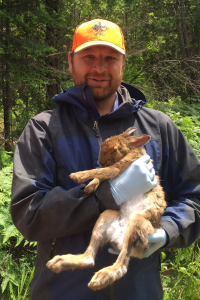
Eric Clark, wildlife biologist for the Sault Tribe of Chippewa Indians.
By Chloe Trofatter
Michigan State University and the Sault Ste Marie Tribe of Chippewa Indians are fighting climate change while preserving Anishinaabeg cultural practices.
Incorporating Indigenous voices and working with the Sault Tribe has transformed their approach to science and research, according to both Gary Roloff and Eric Clark, co-leaders of MSU’s newly established Center for Cooperative Ecological Resilience.
The center integrates Indigenous and Western sciences to improve and adapt natural resource management.
“One of the big challenges we’re facing is how to integrate Indigenous ways of acquiring knowledge with Western science,” said Roloff, professor and chairperson of MSU’s Department of Fisheries and Wildlife.
The center primarily works with the Sault Tribe and, in the past year, has focused on fire ecology and the use of prescribed fire in the restoration of Michigan forests.
Fire, or ishkode to the tribe, is an important part of their culture and a tool that can be used for wildlife management.

This story is part of an occasional series called “Climate Solutions.”
Climate change has increased the risk and potential damage of wildfires in the United States, according to the Center for Climate and Energy Solutions.
“We’ve had 100 and some plus years of essentially industrial forest management, this very extractive practice,” said Clark, lead wildlife biologist for the tribe’s wildlife program. “That doesn’t work, that doesn’t create sustainable landscapes that we can depend on.”
To the Anishinaabeg people, including the Sault Tribe, ishkode is a spiritual being of creation and regrowth.
The tribe maintains a relationship with ishkode and, in return, it takes care of the land, said Danielle Fegan, a member and assessment biologist for the Sault Tribe and a student at the center.
Prescribed fires are controlled, planned fires that return nutrients back to the soil, promote growth in native plants and trees, and curb wildfires by clearing underbrush in overcrowded forests, according to the U.S. Forest Service.
“The Sault Tribe has a long relationship with fire in this area, and some fire prevention strategies that have been widely implemented have taken away from that relationship,” she said. “It’s important to restore that relationship and, as an added benefit, take care of the animals and plants that live there as well.”
In 1910, after a series of wildfires in Montana, Idaho and Washington, the forest service instituted policies of fire suppression, according to the Forest History Society, an archive of conservation and forestry in North America.
These policies prevented and suppressed fires by creating what is now the service’s wildland firefighting program and effectively banning prescribed fire, despite its wide use for land management, according to the society.
In August, Randy Moore, chief of the forest service, announced restrictions on prescribed burning in the wake of the California wildfires.
A group of over 40 forest and fire scientists from across the country wrote a letter protesting the new policy. They wrote that “Even if temporary, these directives will significantly limit options for resource managers in a time when increasing the pace and scale of forest restoration and fuel reduction is of critical importance.”
And forest managers are looking for more tools and more options.
“Future scenarios suggest that we’re going to have a lot more fire prone landscapes,” said Clark, the Sault Tribe’s wildlife biologist. “So, I would argue that we try to bring back traditional land management practices, or we can just let it burn and see what happens.”
The center has given Fegan the opportunity to approach climate change science and adaption with an “Indigenous worldview,” she said. Currently, she is researching the impact of ishkode on grouse species in the Hiawatha National Forest.
“The center tries to adopt projects that have direct relevance to tribe culture,” said Roloff.
These projects often take the form of land restoration – like coastal marshes along the St. Mary’s River or “boreal remnant ecosystems,” which are ecosystems from northern regions that are being pushed further north by warming climates.
White cedar trees, or giizhik, are native to Michigan and one of the focuses for the center. The trees are culturally significant for the Anishinaabeg, but they also provide habitat for snowshoe hare, or waabooz.
The center’s work with waabooz represents how Indigenous culture and western science can conflict, said Clark, who is connected to the tribe through his wife, Robin, who is a member of the tribe and a forest ecologist with Michigan Technological University.
“Resource managers are constantly putting species in the winner or loser bin – in general just saying, ‘well snowshoe hares are a climate loser, so we’re going to start thinking about cottontail rabbits instead,’” he said.
“That’s not an option. It’s not the cottontail rabbit that’s littered throughout Anishinaabeg creation stories, it’s the snowshoe hare, it’s waabooz,” Clark said.
Roloff said that the partnership informs his science.
“Now that I recognize those two ways of knowing, it has made me a better scientist because I look more holistically at the ways that I am studying,” Roloff said.
“The tribes have a different way of acquiring knowledge than Western scientists,” We were taught the scientific methods, and that’s a perfectly legitimate way of acquiring knowledge, but the tribes have a way of acquiring knowledge over time and passing on information from generation to generation.”
Fegan is using her Western-science-based education and Indigenous ties to the land to fuel her work.
“In my personal and my work life, I’ve acknowledged some responsibility for taking care of these places,” she said.
“Anishinaabeg folks, including the Sault Tribe, have had long relationships with the land and everyone else that lives here – including the water and wildlife, tree species and down to micro-organisms,” she said. “So, I think that puts us in a good spot to take care of this land and these ecosystems.”